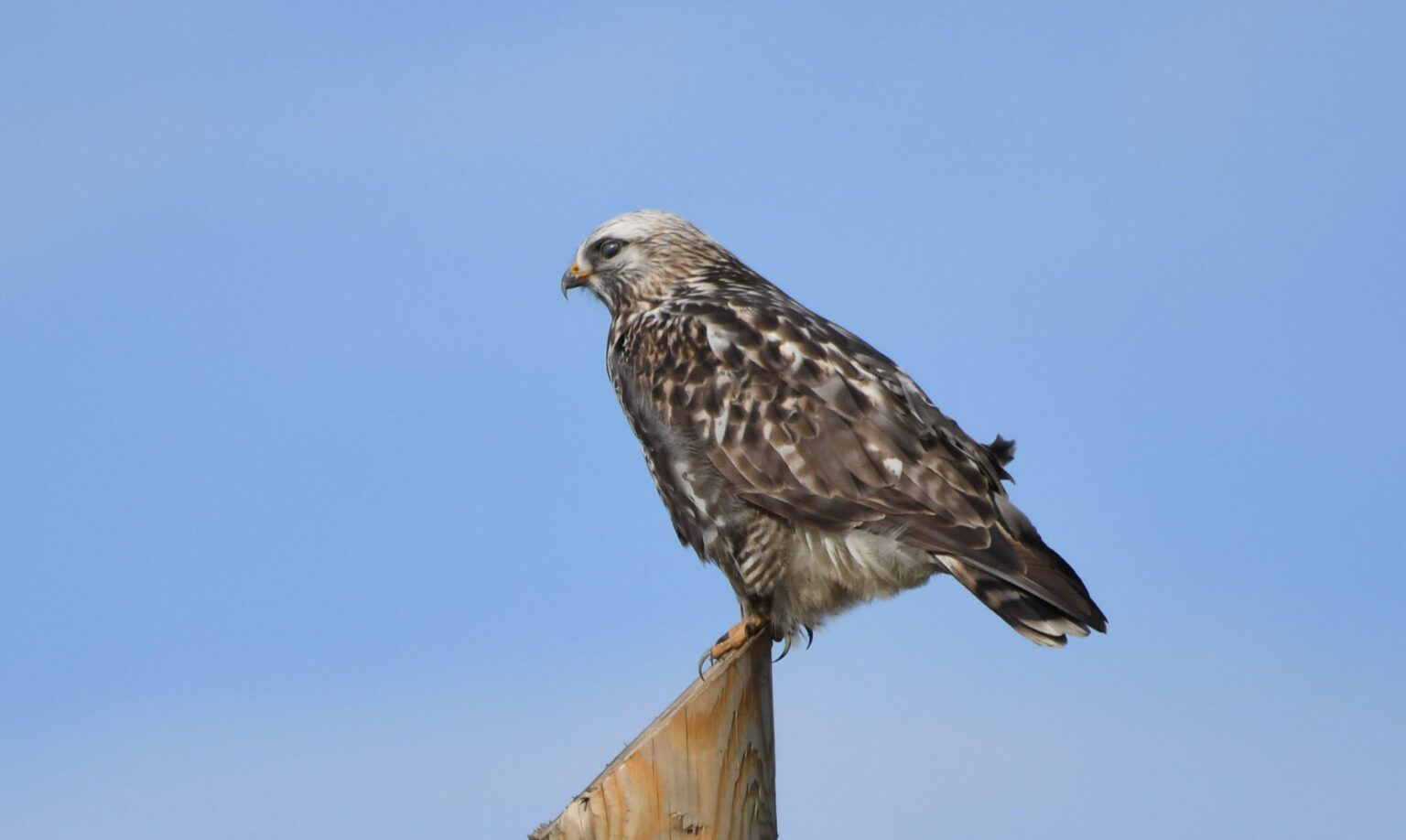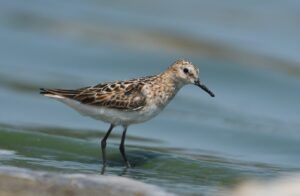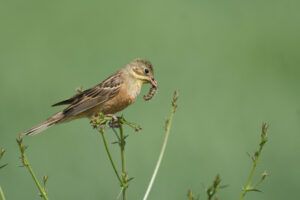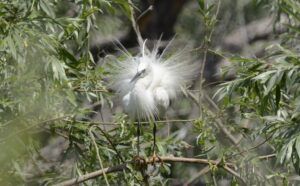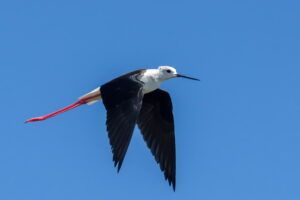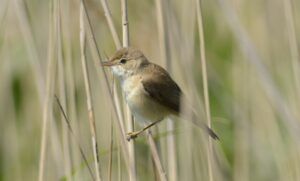The Rough-legged Buzzard (Buteo lagopus), called the Rough-legged Hawk in North America, is a medium-large bird of prey. It is found in Arctic and Subarctic regions of North America and Eurasia during the breeding season and migrates south for the winter.
Nests are typically located on cliffs, bluffs or in trees. Clutch sizes are variable with food availability but 3–5 eggs are usually laid.These hawks hunt over open land, feeding primarily on small mammals. Along with the kestrels, kites and Osprey, this is one of the few birds of prey to hover regularly.

This fairly large raptorial species is 46–60 cm (18–24 in) with wingspan ranging from 120 to 153 cm (47 to 60 in). Individuals can weigh from 600 to 1,660 g (1.3 to 3.7 lb) with females typically being larger and heavier than males. Among standard measurements in adults, the wing chord is 39.2–48.3 cm (15.4–19.0 in), the tail is 20.1–25.5 cm (7.9–10.0 in), culmen is 3.2–4.5 cm (1.3–1.8 in) and the tarsus is 5.8–7.8 cm (2.3–3.1 in).The plumage is predominantly brown in colour and often shows a high degree of speckling. A wide variety of plumage patterns are exhibited in light vs. dark morphs, males vs. females and adults vs. juveniles. Extensive field experience is required to distinguish between certain plumage variations. Compared to its more common cousins, the Common Buzzard and the Red-tailed Hawk, it is slightly larger, though may be outweighed by the latter.
Its feet are feathered to the toes (hence its scientific name, lagopus, meaning “hare-footed”) as an adaptation to its arctic home range. Lagopus is derived from Ancient Greek lago (λαγως), meaning “hare”, and pous (πους), meaning “foot”. Its talons are relatively small, reflecting their preferred choice of prey. A broad brown chestband is present in most plumages and a square dark carpal patch contrasting with the white under-wing is an easily identifiable characteristic in light morph individuals. The species exhibits a wide variety of plumage patterns including light and dark morphs.
Distinguishing characteristics in all plumages include long white tail feathers with one or more dark subterminal bands. The wing tips are long enough to reach or extend past the tail when the animal is perched.The Common Buzzard can be similar-looking, with a similar long-tailed shape and can be notoriously variable in plumage. The Rough-legged is longer-winged and more eagle-like in appearance. The Red-tailed Hawk is chunkier-looking and differs in its darker head, broader, shorter wings, barring on the wings and the tail, dark leading edge to the wings (rather than black wrist patch) and has no white base to the tail. The Ferruginous Hawk is larger, with a bigger, more prominent bill and has a whitish comma at the wrist and all-pale tail.
It is the only hawk of its size (other than the very different-looking Osprey) to regularly hover over one spot, by beating its wings quickly.
The Rough-legged Hawk is a member of the genus Buteo, a group of moderately large raptors exhibiting broad wings, short tails and wide robust bodies. This group is known a hawks in North America but referred to as buzzards in Europe.
There are at least 3 recognized subspecies of Buteo lagopus:
- B. l. lagopus is the nominate subspecies. It breeds in northern Europe and Asia and has relatively dark plumage. The dorsal feathers are a homogeneous brown colour, contrasting well with the paler head.
- B. l. sanctijohannis breeds in North America. It has pale, speckled dorsal plumage and is slightly smaller than B. l. lagopus.
- B. l. kamtchatkensis breeds from north Siberia to Pacific North America. It has paler plumage when compared with B. l. sanctijohannis and it is, on average, the largest of the three subspecies
- The Rough-legged Hawk breeds in tundra and taiga habitats of North America and Eurasia between the latitudes of 61 and 76° N. Rough-legged Hawks occurring in North America migrate to the central United States for the winter, while Eurasian individuals migrate to southern Europe and Asia. It is the only member of its diverse genus found in both of the Northern continents and has a complete circumpolar distribution. During these winter months, from November to March, preferred habitats include marshes, prairies and agricultural regions where rodent prey is most abundant.Breeding sites are usually located in areas with plenty of unforested, open ground. Depending on snow conditions, migrants arrive at breeding grounds during April and May. Home ranges vary with food supply but are commonly reported to be 10–15 km2 (3.9–5.8 sq mi) during the winter, but little is known about home ranges during the breeding season. Although frequently attacked in skirmishes by other highly territorial birds such as gyrfalcons and skuas, the Rough-legged Buzzard is not strongly territorial.

- This species is carnivorous, typically feeding on small mammals, which make up 62–98% of its diet. Lemmings and voles are the major prey items of this species, seasonally comprising up to 80–90% of their prey, but this varies with seasonal availability. Some evidence suggests that these hawks may be able to see vole scent marks which are only visible in the ultraviolet range, allowing them to cue in on prey.The Rough-legged Hawk will also supplement its diet with mice, rats, gerbils, pikas and insects. Besides mammals, birds are the second most favored type of prey for Rough-legs. Most avian prey species are small passerines such as Snow Buntings, Lapland Longspur and American Tree Sparrow. However, they will also prey on birds slightly larger than the passerines typically targeted, especially ptarmigan, as well as waterfowl, shorebirds (such as Ruffs) and Short-eared Owls. They usually target bird prey which are young and inexperienced, with relatively large avian prey itmes often being snatched in their fledging stage. When small mammals are scarce, the Rough-legged Hawk will also feed on larger, medium-sized mammals including prairie dogs, ground squirrels, muskrats and weasels. During winter, shrub-steppe habitats seem to encourage a strong dependence on rabbit prey. In developed areas of England, Rough-legged Buzzards have been recorded preying most regularly on relatively large prey such as common wood pigeon and invasive European rabbits.This avian predator hunts opportunistically, occasionally supplementing their diet with carrion, but focusing primarily on the most locally abundant small vertebrates. Rough-legged Hawks will steal prey from other individuals of the same species as well as other species such as the Red-tailed Hawk, Northern Harrier, American Kestrel and Common Raven. Prey sizes typically range from 6.5–2,587 g (0.23–91.3 oz) and adults require 80–120 g (2.8–4.2 oz) of food daily.These raptors hunt during the daytime. Like most Buteos, Rough-legged Buzzards have been reported both still-hunting (watching for prey from a perch and then stooping) and watching for prey while in flight. Unlike other large raptors, they may engage in hovering flight above the ground while search for prey.
- Sexual maturity is reached at about two years old. Breeding generally occurs during May but is variable depending upon dates of arrival at breeding grounds. The Rough-legged Hawk is thought to be monogamous, mating with a single individual for multiple years. No evidence currently suggest otherwise.Nests are built soon after arrival to breeding grounds and require 3–4 weeks to complete. Twigs, sedges and old feathers are used as building materials. Nests are 60–90 cm (24–35 in) in diameter and 25–60 cm (9.8–24 in) in height. Cliff ledges and rocky outcroppings are preferred nesting sites. Females can lay 1–7 eggs but will typically lay 3–5. Average egg size is 56.4 mm (2.22 in) in length by 44.7 mm (1.76 in) in width. Minimum incubation period is 31 days, provided almost exclusively by the female. The male feeds the female during this incubation period. After hatching, young require 4–6 weeks before fledging the nest. Fledglings depend on parents to provide food for 2–4 weeks after leaving the nest.
- Rough-legged Buzzards that survive to adulthood can live to an age of 19 years in the wild. One female being kept in an Idaho zoo is over 25 years of age. However, perhaps a majority of individuals in the wild do not survive past their first two years of life. The threats faced by young Rough-legs can include starvation when prey is not numerous, freezing when Northern climes are particularly harsh during brooding, destruction by humans, and predation by various animals. The chances of survival increase incrementally both when they reach the fledging stage and when they can start hunting for themselves. Death of flying immatures and adults are often the result of human activity, including collisions with powerlines, buildings and vehicles, incidental ingestion of poison or lead from prey or illegal hunting and trapping

- Adult Rough-legged Hawks will vocalize alarm calls when intruders approach a nesting site. It is described as a downward slurring whistle, sounding like kiu wiyuk or a lengthy descending kee-eer similar to that of the Red-tailed Hawk. This cry is given in flight or from a perch every 15–30 s. During courtship, both sexes have been recorded to give a whistling sound that changes to a hiss. Following copulation, females will give a clucklike sound and males vocalize a whistling noise. Fledglings will give begging calls while waiting for parents to provide food.
- In the Danube Delta only in winter time. Easy to see.
- photo : Mihai BACIU

